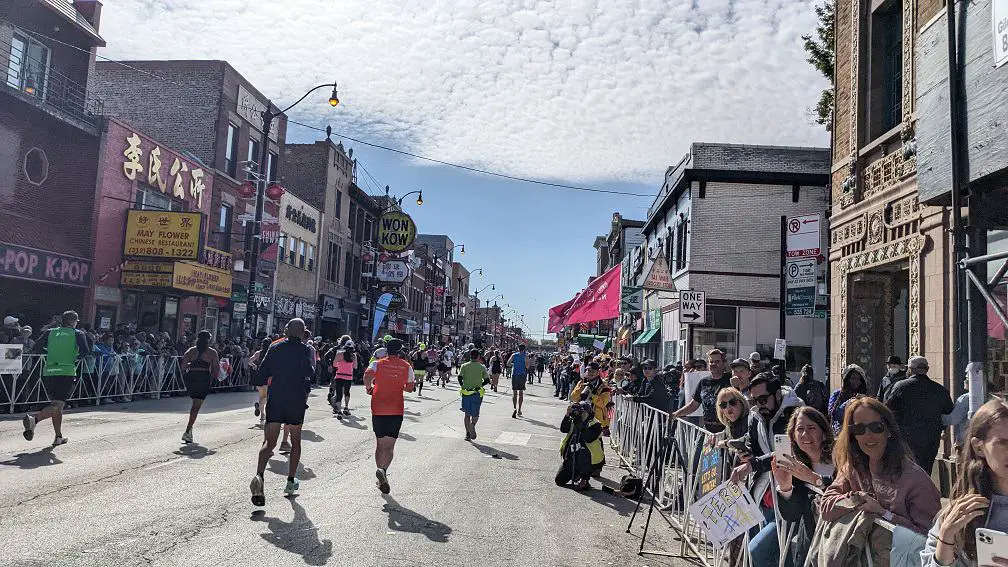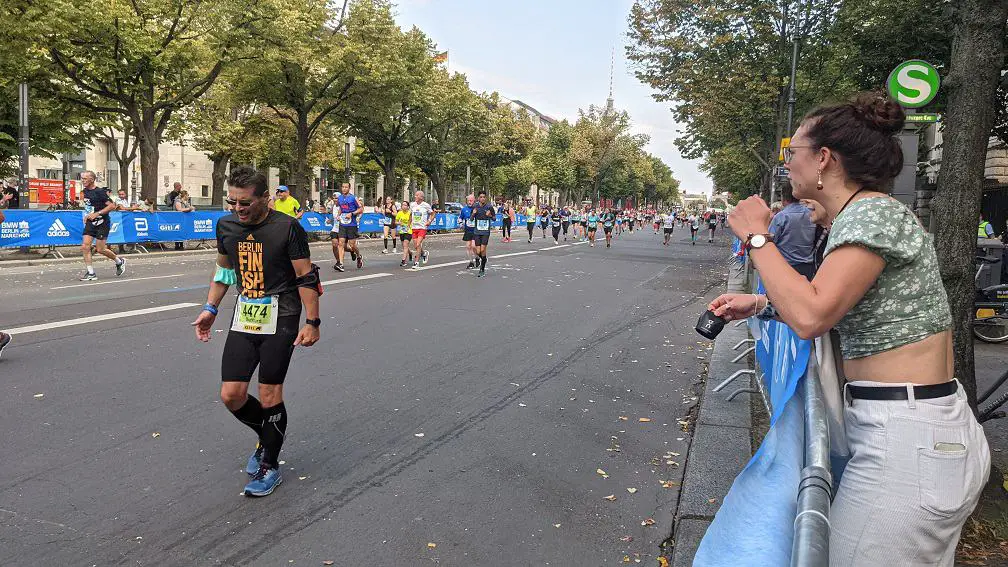You’ve been training for months, and the big day arrives. Nervous and excited, you have a plan. You know the pace you will run, and you can’t wait for your marathon to start!
This describes me at the start of all eight marathons I’ve completed. In all but two, I’ve had to walk at some point.
Be it the conditions (Berlin 2022 was so hot) or not quite as fit as I should have been (Chicago 2022, I’d had covid eight weeks before). I couldn’t sustain the pace I set out at, and by around mile 20, I hit the wall to a greater or lesser extent.
Despite the walking, I finished them all, and the medals are proudly on my wall.
This article considers various aspects of walking during a marathon and describes the run-walk method and even walking the entire 26.2 miles.
Table of Contents
What is the run-walk method for marathon runners?
Jeff Galloway is widely considered the expert on the run-walk method for marathon runners. He has written several books on the subject and created a successful training program based on his research.
His Run Walk Run program aims to allow runners to finish their long races with fewer injuries, increased endurance, and improved speed.
This is accomplished by combining walking periods with running intervals throughout a training cycle and race.
Many marathon runners have found success with this evolved approach to training, as Jeff Galloway has developed a comprehensive program that encourages one to increase their mileage and race goals gradually.
The run-walk strategy improves running times, stamina, and greater confidence when competing. This method will enable one to enjoy running a marathon without exhausting one’s body or risking injury.
Pros And Cons Of Using The Run-walk Method
The Jeff Galloway run-walk method has pros and cons when used in marathon running.
Pros include: it helps to reduce fatigue, provides pace control, gives the runner a chance to take in nutrition, creates better mental focus during the race, is easy for beginners to follow, and gives rest and recovery times.
Cons include: being time-consuming, hard to stick to an overall goal time due to frequent walk breaks, may cause runners to lose their focus on technique and efficiency as they transition into a walking pace, and can be difficult for dedicated runners with a set training plan to adjust.
How To Use The Run-walk Method During A Marathon Race?
Beginners interested in using the Jeff Galloway run-walk method during a marathon should start by doing simple walk breaks.
Start with basic intervals such as 1 minute of running and then 2 minutes of walking, repeated multiple times throughout the race. Gradually increase the time of your running interval while maintaining the same amount of walking.
This will help you build up endurance during your runs and help you to become familiar with the run-walk pattern. Also, it is essential to adjust your pace accordingly so that you can finish your marathon within an acceptable amount of time for yourself.
Walking The Entire Marathon Distance?
Walking an entire marathon is indeed possible, and it could be a rewarding way to take on the challenge of completing the distance – but it comes with its own unique set of demands.
The slower pace requires a great deal of physical and mental strength and will require an entirely different strategy for success than running.
You should be able to check with the marathon organizers to avoid falling foul of a tight time cut-off. Most large marathons allow up to six hours for people to complete the 26.2-mile distance. A time that will allow you to complete the course while walking at a good pace.
Don’t start close to the front of the race. You want to avoid holding people up during their runs. When adequately prepared, walking an entire marathon can be as rewarding as running.

Know Marathon Route And Plan Your Walks
Knowing the marathon route and its inclines before the start of the race is essential for anyone starting a marathon. If there are any significant inclines, it is best to decide in advance to walk that section to save energy and avoid blowing your legs.
This will allow you to maintain a steady pace throughout the marathon and give you greater control over your finish time.
Additionally, being familiar with the terrain can help you plan strategically by knowing when the more challenging sections will come up so that you can adjust your pace accordingly (up or down).
Picking Up An Injury A Few Weeks Out From Race Day
Picking up an injury a few weeks from race day can be daunting. It might mean that you have to adjust your training plan or race day strategy to include walking or, even worse, not being able to participate in the marathon.
If this happens, it is vital to seek medical help and advice as soon as possible so that the root of the injury can be pinpointed and treated appropriately. In addition, it is also important to rest and allow any strains or pains ample time to heal before attempting to run the marathon distance.
Final Thoughts
Most marathon runners have had to take walking breaks at some point during their marathon running careers. It’s nothing to fear or to be ashamed of.
This is especially true the further into a marathon you get. There are so many things take need to go well on the day, such as, knowing your fitness level, fueling strategy, the conditions, and how crowded the route is. If just one of those goes differently than planned or expected, you may find yourself walking.
The critical thing to remember is that you are one of the 1% of humans who will have ever completed the distance, walking or running!
The important thing is that after the race, you examine your race day experience and try to work out where you could improve and plan for that.
The pictures in this post were taken while walking in a marathon I’d intended to run from start to finish. Without those walking breaks, I wouldn’t have taken the time to go for my phone and take a picture of two.

FAQ
How Long Does It Take To Walk A Marathon?
At four mph, it will take just under 7 hours to walk a marathon. At three mph, it will take just under 8 hours to walk a marathon.
Is Walking A Marathon Harder Than Running One?
You will likely work up a sweat when walking, but you’ll expend less energy when walking than when running.
That said, many people find that walking is far more grueling on the body in a different way because it takes longer and requires a great deal of endurance.
Whether you plan to walk or run your upcoming marathon, preparing yourself adequately will ensure success regardless of your chosen approach.
Can You Walk A Marathon Without Training?
While not a good idea, most people could walk a marathon distance without training if they had to. A better idea would be to prepare as much as possible with the time available.
Is It Ok To Walk During Marathon Training?
Yes, it is perfectly fine to walk during marathon training. Walking can be an effective way to improve stamina, strengthen the legs and build mental endurance.
By including walking as part of a marathon training program, runners can reduce their risk of injuries from overtraining and ensure they are adequately prepared for race day.
Short walking breaks throughout training runs can also help prevent exhaustion and burnout. Ultimately, walking during marathon training should be considered an essential part of any runner’s workout regimen.
Is It Disrespectful To Walk During A Marathon?
No, it is not disrespectful to walk during a marathon. Many runners choose to incorporate walking into their race strategy as it helps them conserve energy and maintain proper form.
Running a marathon is an incredibly challenging feat, and there should be no shame in taking walking breaks along the way. No matter how you conquer the miles, respect and admiration should be given to all participants for their commitment and dedication.



